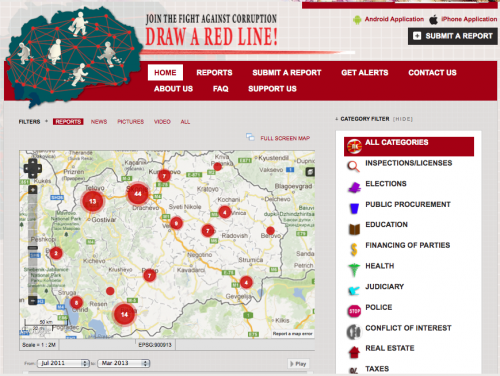[Guest post about Draw a Red Line from Metodi Zajkov, Secretary General for
Transparency International - Macedonia and Dimitri Neos, Executive Director from Center for International Relations . Ushahidi would like to extend our Congratulations to Deployment of the Week and Transparency International (TI) grant recipient, Draw a Red Line. They are investigating how to connect their map data with TI's database. See more about other winner's The Engine Room.]
A joint effort by Transparency International-Macedonia and the Center for International Relations deployed in 2012, its Transparency Watch project utilizes Ushahidi to empower citizen reporting of alleged acts of corruption. Ushahidi is used as a central focus of a general anti-corruption campaign, providing a platform for citizens to report corruption via the Ushahidi web site and mobile apps (Android and shortly, an iPhone app) as well as phone and email.
Citizen reports have resulted in investigation of 121 reports, 37 of which have been verified to date.
Results of these efforts have included:

- A citizen report that led to an investigation of electrical counter utilization charges and associated violations of consumer electric energy charges. As a result, preparations are being made to challenge the constitutionality of the Energy Regulatory Commission of Macedonia Tariff.
- A report that led to investigation of improper property taxes that was determined to have occurred over the last five years in the Skope Center 2 region. Upon finishing the analysis, TI-Macedonia informed the region’s citizens of their rights to request recourse from the city.
- A report regarding the abuse of worker’s rights resulting in a government inspection. Their findings supported the allegation and a notice to desist all irregularities was effected.

Processing Anti-Corruption Reports With Due Diligence
Transparency International – Macedonia provides all of the on-the-ground investigations of corruption reports. A rigorous investigation process TI-Macedonia has in place determines the validity of the report. This initial investigation is performed within a week of the report received date. A determination is made whether the report has merit for further investigation or whether it should be passed on to a different entity/organization. After this, further investigation (gathering additional information from holders) of the report may be needed which may last months before resolution. TI-Macedonia works closely with the citizens throughout the process and, in many cases, provides consultation on steps for legal remedies. TI-Macedonia cooperates on institutional level with various governmental entities to provide necessary information on the merits. Presenting a true picture through report metrics and related details through Ushahidi can be an involved process, starting with identification of what metrics provide true measures of the project’s activities, objectives, and outcomes. Poorly identified (and displayed) data not only gives the public a false picture of what’s really being reported but does not provide the organization accurate information views that can be used monitoring and evaluating the project. In our project, that has included effectively analysis of cases and reporting patterns; and managing project campaigns better. The default setting of Ushahidi provides a raw count of citizen reports in its displays. While we have found this useful, we needed another subset of data: verified reports. Listing all citizens reports received can result in a number of issues including: •Unsubstantiated and false reports inflating numbers •Unsubstantiated and false reports providing incorrect and possibly injurious information For this reason, we have split out the types of reports into two categories: Received reports - Raw count. This raw count is displayed on the site but no details about individual reports are shown unless verified by the TI-Macedonia staff. The successful outcome of the information gathering stage may be intercepted by early warning (i.e. publishing the received report on the list. Hence, there is always a significant number of reports waiting for the conclusion of the investigation process to become readily visible on the web list of received or verified reports. Received reports – Listed. As mentioned above not all of the reports are verified at once. Some never get verified at all. Never the less, all the reports that may not interfere with the investigation phase are listed together with reports that do not get verified. However those reports get attached the information from holders that show the suspicion was not reasonable. Received reports – Verified. Only those reports that have been verified are displayed. Details of the report may be shown on the site after being agreed-to by the citizen. The report is being verified after the investigation stage showed sustained proof for the reasonable suspicion eider explicit or implicit to be further examined by the authorized bodies. Both Listed and Verified reports are usually supported by comment of the TI-Macedonia staff.Safeguarding Identities
Reports of corruption are inherently of risk to the person reporting it. Ensuring personal identity information is secure and is of paramount importance. To protect citizens, details of reports are only shown on the site when approved for displays by the reporting party(s). Moreover, any personal information is not displayed on the site.Making It Work
Understanding business needs, processes and objectives are crucial to developing a good Ushahidi design. In general, our project has found these high level steps to be useful:- Identify and define what you want to measure
- Identify and define processes to accurately capture, monitor and evaluation that data (including roles and responsibilities of involved parties)
- Ensure the safety of personal identifiable information of the reporting party.
- Refine business processes and activities based on data captured.